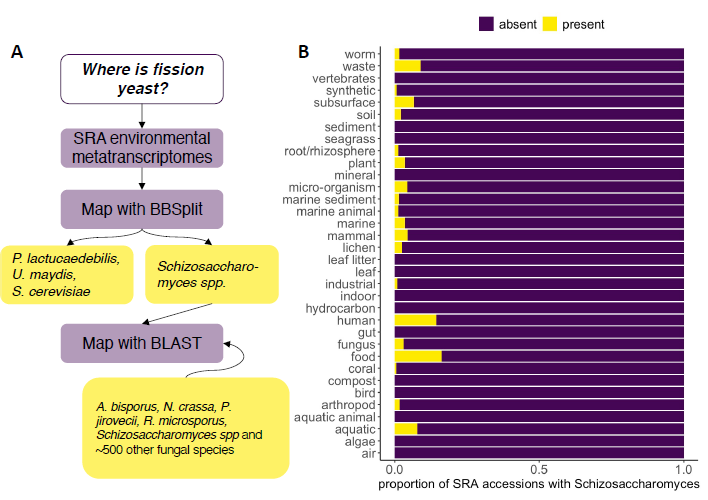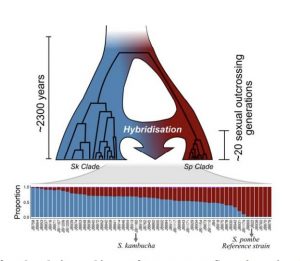Micro-organisms are everywhere. On any surface, in liquids, in the air, everywhere propagules, spores or living growing cells can be found. But how to know if what you can find at a specific location is the place the organism is actually growing?
To understand how selection affects evolution of an organism, the natural habitat of said organism needs to be known; it are the circumstances the species experience in that environment that shape its life history. For many oranisms, especially microorganisms we just don’t know, and this includes the model yeast species, Schizosaccharomyces pombe, the fission yeast we use in my lab.
As a master student, Rasha Shraim (now PhD student at SFI Centre for Research Training in
Genomics Data Sciences and School of Medicine at Trinity College Dublin, Ireland) took up the challenge of finding the natural habitats of fission yeast using publicly available meta-transcriptomic data sets. Assuming that active growth means that the cells are actively expressing their genes, we combed through a large number of raw sequences, searching for any reads that have very high similarity to one of the fission yeast species (S. octosporus, S. japonicus, S. pombe, or S. cryophilus) and deducing where the natural habitat of fission yeasts is.

The results from this endeavor are now published in Yeast. After digging through some 13,000 data sets, the main conclusions are that, fission yeast can be most easily found in association with food, honey and drink – as expected, as this is where fission yeast is most easily isolated from – but can also be found in association with insects and other land arthropods. The yeast is probably quite rare, but a successful and opportunistic colonizer/contaminant of high sugar substrates. You can read more in
Shraim, Rasha, and Bart P. S. Nieuwenhuis. 2022. “The Search for Schizosaccharomyces Fission Yeasts in Environmental Metatranscriptomes.” Yeast In press. https://doi.org/10.1002/yea.3689.
 We just posted a preprint of our manuscript on bioRxiv. In the paper we analyzed the sequencing data from 161 different fission yeast strains and showed that these are a recent hybrids between (at least) two populations that diverged from each other about 2300 years ago, and about 20 outcrossing generations (probably sometime in the last 500 years) started to hybridize. The genomes still have large haplotype blocks from the two different populations. Long-read sequencing methods (PacBio’s SMRT and and NanoPore’s MinIon) showed some small structural variants and a few large structural variation, but these variants are present only at low frequencies and do not explain the haplotype blocks.
We just posted a preprint of our manuscript on bioRxiv. In the paper we analyzed the sequencing data from 161 different fission yeast strains and showed that these are a recent hybrids between (at least) two populations that diverged from each other about 2300 years ago, and about 20 outcrossing generations (probably sometime in the last 500 years) started to hybridize. The genomes still have large haplotype blocks from the two different populations. Long-read sequencing methods (PacBio’s SMRT and and NanoPore’s MinIon) showed some small structural variants and a few large structural variation, but these variants are present only at low frequencies and do not explain the haplotype blocks.